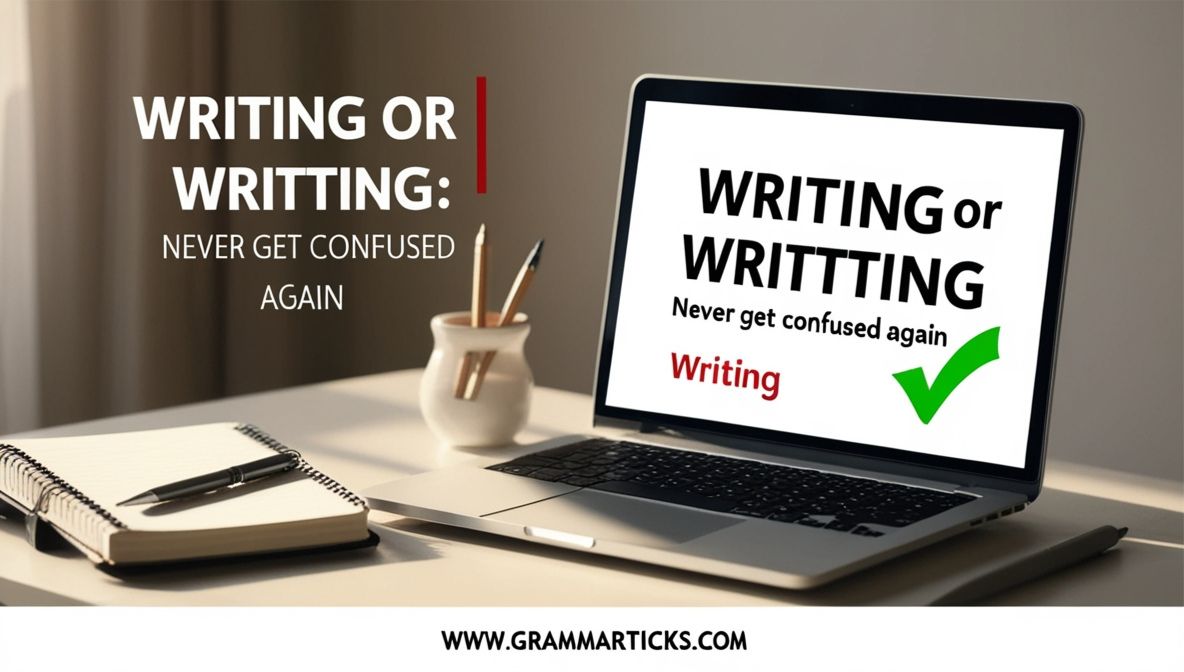Ever find yourself hesitating before typing “writing or writting”? You’re not alone. Spelling can get tricky, especially when it comes to adding suffixes like ing. Many people confuse these two forms, but only one follows proper English spelling rules. Let’s clear that up for good.
In this article, you’ll learn the focus keyword and see exactly why writting is incorrect. We’ll break down the rules for adding -ing in English, explain the silent “e” spelling rule, and show how it applies to write → writing. By the end, you’ll never question the correct spelling of writing again—whether you’re jotting a note or composing a novel.
Why Do People Get Spelling Confusion Around Writing
Many learners and native speakers debate writing vs writting simply because double consonants sneak into their thinking. English pronunciation often differs from its spelling; silent letters and phonetic assumptions lead people astray. Once you know the English spelling rules, the error fades.
Writing vs Writting – Which One’s Correct
Writing is always correct. Writting is a misspelling. People often try to apply the double consonant rule incorrectly, mixing up verbs like fitting or hitting with writing. Spell‑checkers may miss it, but grammar rules won’t lie.
Tips to overcome confusion: always remember write → writing, drop the e, don’t double the t. Use tools or flashcards to drill the rule.
The Rule: Drop Silent e and Don’t Double t
When you add ‑ing to a verb ending in a silent e, you drop the e (write → writing) (turnitin.com). You only double the final consonant when the word is one‑syllable, ends in single vowel + single consonant, and the suffix starts with a vowel (e.g. run → running) (reddit.com). Write ends with a silent e, followed by silent vowel pattern, so you drop the e and add ‑ing. No doubling.
Writing Meaning and Usage
Writing can be a verb (I am writing a letter) or a noun (My writing improved). It refers to composing text, journaling, or any form of written communication. It spans creative writing, academic writing, business writing, and more.
Example scenario:
- You’re writing an email to a client (verb).
- You admire someone’s writing style (noun).
Similar Words Following the Same Rule
| Base Verb | Present Participle | Notes |
|---|---|---|
| make | making | Drop silent e |
| take | taking | Consistent with write → writing |
| come | coming | Irregular vowel but follows rule |
These all follow the same silent “e” drop rule and avoid doubling consonants unless stressed and single‑syllable.
Scenario Examples to Spot the Mistake
Incorrect: I am writting my report. Correct: I’m writing my report.
Incorrect: She was writting notes as her friend spoke. Correct: She was writing notes.
Tip: Say the base verb write in your head: if it ends in ‑e, drop it before ‑ing.
Synonyms and Nuance of Writing
You can swap writing with others depending on tone:
- composing (formal, academic)
- drafting (planned, initial version)
- penning (creative or poetic)
- scribbling (informal or quick)
Use these if you need variety or nuance in tone and context.
Etymology of Writing
The word writing comes from Old English writan (“to scratch, outline, draw”) and evolved into the modern verbal noun by about 1200 CE (en.wikipedia.org, etymonline.com). Over centuries, it became associated with the act of composing text, eventually broadening to include any system of visible communication.
Tips to Avoid Spelling Mistakes
- Memory trick: Always drop the silent e when adding ‑ing (write → writing).
- Flashcards: Quiz yourself on commonly miswritten words.
- Use a simple diagram: write → drop e → writing.
- Spell‑check tools help but also learn manual rule: you won’t learn if auto‑correct does it for you.
FAQs
No, writting is always incorrect.
Because write ends in a silent e, so you drop it and don’t double the consonant.
Understand the silent e rule and practice; memorizing without rule often fails.
Conclusion
Now you know the answer to “writing or writting” only writing is right. The word writting is a mistake. Just remember the main keyword rule: drop the silent e before adding ing. That’s how we get write → writing.
These simple English spelling rules can save you from common errors. Practice them. Say the word out loud. Use it in a sentence.
The next time you write, you won’t think twice. You’ll know it’s writing, every time. Clear, correct, and confident that’s how spelling should feel.

